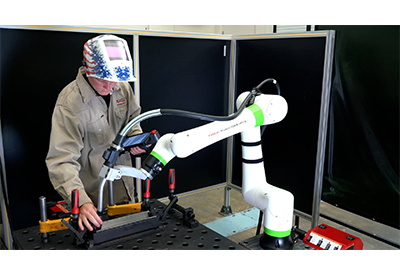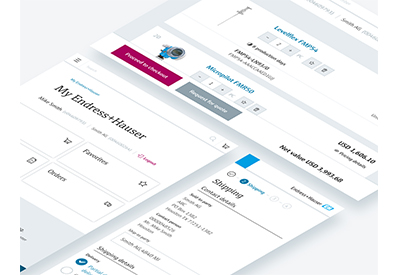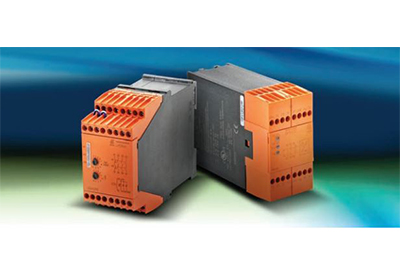Advice for Metal Fabricators: Consider a Cobot

March 9, 2022
A recent report released by the Department of Labor states that a record 4.4 million people quit their jobs in September 2021 as job openings remained unchanged at 10.4 million. So, while there are plenty of available jobs, many companies are having a tough time finding workers. This is particularly troubling for metal fabricators looking to keep up with increased demands that require skilled welders.
“A huge factor right now is the lack of welders in the market and available to work,” says Gary Kowalski, regional sales manager, material joining sales team, FANUC America Corp. “Nobody can find welders to fill job openings. Many companies are offering higher wages, shorter work weeks and other measures just to get skilled people in the door.”
So, for the hundreds of companies struggling to keep up with their customers’ demands, robots and collaborative robots, or cobots, in particular, are the right answer. But what about small to medium-size manufacturers that have not used robots in the past to tackle their welding operations? These companies are looking for ease of use and speedy deployment. Larger companies can afford to spend a lot of time to create a highly productive and focused system for a single type of part. Smaller companies need to weld a wide variety of low-volume parts right now.
It’s common knowledge that many simple manual welding tasks are the culprit behind repetitive motion injuries and downright boredom for skilled welders. But, pop a cobot into the workcell, get it up and running in less than 30 minutes, and it’s ready to take on the job at hand. Welding cobots not only help reduce costs, but they allow skilled welders to focus on the complex jobs that require their expertise while maintaining quality welds.
Welding benefits
“FANUC has an automation solution for any size company – from small shops to large assembly manufacturers,” Kowalski says. “If the job is for a high-volume run, possibly an automotive part, FANUC’s traditional high-speed ARC Mate welding robots are well suited to produce as many parts as possible in the shortest amount of time. But for low-volume, high-mix welding applications, the CRX cobot is a great fit.”
The latest CRX welding cobot is quick to set up and easy for any skill level to operate. The CRX cobot welder can be programmed using a touchscreen tablet while the programmer moves the robot to the desired weld location on the part.
“It’s really a short learning curve to get up and running quickly,” Kowalski says. “This includes the main feature of the CRX cobot, which is the quick teaching of simple welds. It’s an intuitive process and an operator can learn to perform it almost immediately. They just position the torch on the part, push a button and that program is created.”
It’s common knowledge that most cobots have a lightweight and compact design – but the CRX cobot offers more including industrial ruggedness, reliability and minimal maintenance features. In fact, the CRX can operate for eight years maintenance-free, which is a major advantage for companies looking to lower costs and increase productivity.
A collaborative robot moves slower by design to accomplish tasks and adhere to safety requirements. High-volume welding projects require the robots to move as fast as possible to make the most parts with the fewest robots. These robots are usually equipped with rotating fixtures and automatically clamping end-of-arm-tools that require safety barriers to protect people. The collaborative robot works at a table side-by-side with a worker, without moving fixtures or clamps – in other words, just perfect for basic job shop welding but too slow for high-volume production welding.
The CRX welding cobot supports several of FANUC’s advanced features including iRVision, which is a fully-integrated visual detection system that enables robots to see, making production faster, smarter and more reliable.
“We have also released our advanced features from the ARC Mate robots to the CRX cobot, including Touch Sensing, and TAST (Through-Arc-Seam-Tracking),” says Kowalski. “This allows us to cover a complete range of collaborative applications while maintaining an ease of use programming environment that the market is calling for. When I talk with customers looking to automate a particular welding project, I suggest the CRX cobot as a great starting point. As their business expands to the point that requires higher production rates, they can then easily add ARC Mates to tackle those jobs.”
Since initially introduced to perform material handling, the CRX cobot continues to take on more applications including welding, vision inspection, palletizing, machine tending, vision-guided pick and place, and sanding. CRX cobot e-Learning training modules are available to help operators get up to speed very quickly. There are currently seven online tutorials that cover a product overview with features, unboxing and setup, three programming courses, and two iRVision courses. More learning modules will be added as they become available.
Watch the application videos and learn how the CRX cobot can help companies achieve higher manufacturing efficiency.
















